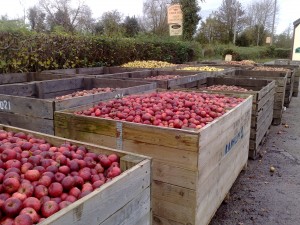– Don’t Believe The Cider Hype
 When talk turns to cider the mind turns to images of idyllic orchards basking in autumnal sunlight, of robust yet handsome thirty-somethings lazing amongst the trees while a vintage truck drives to a Victorian era building with wooden crates of apples ready to be pressed for their juice. Or of a bunch of old red nosed men gathered around a table by a roaring fire in an old barn in some indistinct part of the West Country.
When talk turns to cider the mind turns to images of idyllic orchards basking in autumnal sunlight, of robust yet handsome thirty-somethings lazing amongst the trees while a vintage truck drives to a Victorian era building with wooden crates of apples ready to be pressed for their juice. Or of a bunch of old red nosed men gathered around a table by a roaring fire in an old barn in some indistinct part of the West Country.
At least that’s what the marketing industry would have us believe. It’s a far nicer image to buy into than that of groups of teenagers or tramps chugging from two litre bottles of “white” cider.
Until recently cider only required as little as 7% apple juice to be able to bear the name. The rest was generally water for bulk, sugar for sweetness and a cornstarch and enzyme concoction to give it the alcohol. White cider was generally a little bit of juice, and a lot of other stuff. Not so much autumnal orchards as sterile labs.
However in September 2010 the UK government changed the rules and to be able to call itself cider now it must contain at least 35% apple juice. Some may rail against the use of concentrate in cider, but better concentrate than cornstarch.
But where does that leave our marketing ideals? Are there really orchards in Ireland with those handsome couples lazing about? Does that old Victorian building really exist, ready to accept the apples for pressing? The real Magners isn’t a quaint little orchard, but a great big factory, and not a Victorian one either. Rows upon rows of silos reaching to the skies, all painted a murky brown to blend into the landscape and not be so much the eyesore they are. The image of cider painted by the marketing companies doesn’t fit with the reality of the large brands. To see the reality of the Magners factory, have a look at the Google Street View: here
However, it does apply to cider farms like Dunkertons that have seen an increase in business thanks to those large brands. Dunkertons is based in an old farmhouse, down a winding country lane surrounded by its own orchards. They grow their own apples for their cider and pears for their perry. You can look out from their shop on the farm and see the fruit growing on the trees, depending on the time of year of course.
Magners is proud of using seventeen varieties of apples that it buys from all over Ireland, and they’re shipped in by the articulated lorry load, not a vintage truck. With companies like Dunkertons however a poor harvest from their own trees means that their drinks will be in short supply that year.
But that isn’t where the main difference is noticeable, it’s in the taste. A well-blended whisky needs a lot of care and effort, and a close inspection of quality ingredients, and the same goes for cider. Just throwing whatever you can get into the mash isn’t going to produce the taste and quality you can get from a well-crafted cider.
Words by : Steve Dunkley
chrubble says
3.25 pm
05 May 2011
This is CAMRA page was quite an eye-opener a while ago. Particularly with regard to Thatchers and Addlestones which have the look of real cider. Don’t believe the hype. Look for scrumpy and perry and for the love of mike avoid the b*stardised ‘pear cider’ etc http://www.camra.org.uk/page.aspx?o=nonrealcider
Steve says
1.10 pm
11 May 2011
I agree that there’s too much cr*p out there, but I’m afraid I’m not with CAMRA when it comes to what’s considered a “real” cider or not. I much prefer a cider made purely from fresh apple juice, but I’d rather it had concentrate than very little juice.
And “pear cider” that’s just marketing rubbish to try and get m*gners drinkers over onto perry because they can’t meet the demand from apples.